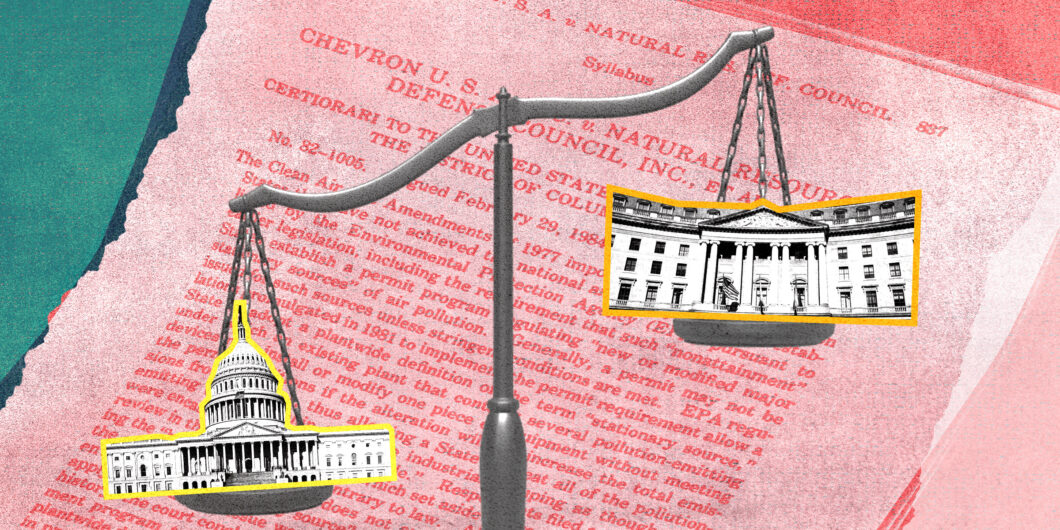A Beautiful Mind is a great film, but the one example it provides of game theory is misleading.
The Post-Chevron Separation of Powers
Under our Constitution’s separation of powers, Congress enacts the laws, the Executive executes them, and the Judiciary interprets them. Chevron deference undermined that essential structure because it created a space where the Executive, not the Judiciary, determined meaning of the law. In doing so, it freed Congress from some of its accountability for writing statutes. As applied to substantial questions, it allowed Congress to abdicate its legislative role by delegating to an agency the power to interpret the limits of its own powers. Eliminating Chevron would help return us to the separation of powers that helps guarantee liberty.
But as Adam White recognizes in his excellent essay, overruling or limiting Chevron would provide only a first step in restoring constitutional administration. Here I offer some additional ideas to help keep the branches in their respective lanes. First, as White also recognizes, many administrative statutes are ambiguous. But ambiguity tempts the judiciary to smuggle in its own policy views as the decisive factors of statutory construction. Without Chevron, the courts, and particularly the Supreme Court, must resolve ambiguity by law—not policy preference—if they are to respect the separation of powers themselves.
Thus, an essential project for the post-Chevron world is for the Court to create a framework of rules for statutory interpretation that apply across subject matters. That enterprise creates a discipline that helps prevent judicial policy frolics. The beginning of this discipline is to recognize that statutes of any complexity (and most administrative statutes are extraordinarily complex) possess a legal meaning. Thus, the Court should not look at a statute’s words in isolation, but in the context of all related statutes—the relevant corpus juris. This corpus juris also includes relevant interpretative rules extant at the time the statute was enacted. The rich legal background of most statutes provides more fixed points to resolve ambiguity.
This suggestion might seem to conflict with some justices’ past statements, where they say they will interpret their statutes according to their “ordinary meaning.” But these declarations are confusing because the term “ordinary meaning” is ambiguous: ordinary as opposed to legal meaning? Or ordinary as opposed to unusual meaning? In his treatise Reading Law, Justice Scalia called for the application of “ordinary legal meaning,” and in practice, most justices follow this method most of the time (albeit not always with the necessary clarity about what they are doing). If lower court judges as well as the Supreme Court justices will no longer be able to punt to administrative agencies when interpretation gets difficult, the Court should reticulate ample available legal resources to disambiguate statutes.
And the Court should welcome discussion of what those resources are. Just last month, Justice Kavanaugh challenged the majority about whether a canon that called for interpreting statutes to favor veterans was sound. These debates about the precise methods statutory originalism entails are important because they provide a framework for statutory interpretation that should not change regardless of the desired policy outcome.
The next step concerns the deference still due to the executive. Even before Chevron, the Court sometimes gave weight to agency interpretations under a doctrine called Skidmore deference. Continuing this kind of deference can be reconciled with overruling Chevron. First, under Skidmore, the Court provides only such weight as the circumstances (such as relevant expertise or presence at the creation of the statute) warrant, rather than a space for agency discretion, within which it accepts any “reasonable” executive interpretation. Second, this deference is only epistemic. The Court defers because it has a reason to believe that agency is in better position to perceive the meaning than the Court. Such epistemic deference is not unique to the agency context but applies throughout the enterprise of judicial interpretation. For instance, the Court gives weight to the views of the first Congress on the meaning of the Constitution of 1789 on the grounds that the members of that Congress provided a contemporaneous exposition of meaning, and that many members had been delegates to either the Philadelphia convention or state ratifying conventions.
Screening for real expertise before providing deference restores an essential administrative distinction between technical expertise and policy judgment—a distinction that was important to justifying the administrative state in the first place.
But the Court needs to make sure that this deference has an epistemic basis. For instance, just because the agency claims that its interpretation of technical words flows from its expertise, does not mean that it actually does. The agency may well have political reasons for giving an interpretation that does not reflect expert knowledge of the way the words are used. Thus, the Court’s new deference doctrine should encourage agencies to undertake processes that guarantee that the expert views they put forward reflect real expertise. For instance, just as the FDA forms committees with outside members to guide their decision to approve drugs, agencies could form focus groups of experts to determine the technical meaning of relevant words in the statute. That kind of evidence would deserve substantial weight, whereas the agency’s view, infected as it may be by politics, may not. Such a procedure would also help reduce the “first mover” advantage that White fears administrations will get when they control the agency that gets the first shot at putting its “expert” gloss on the statute.
Similarly, the Court has long deferred to agencies on mixed questions of law and fact. For instance, in an early administrative law case, they deferred to the National Labor Relations Board’s judgment that newspaper boys were employees. This kind of deference stems again from the view that agencies are in a better position to determine such fact-bound inquiries than courts. While that doctrine is sensible, a concern with its application again is that the agency will be doing politics under the guise of expertise. The Court needs to police this problem, and it has the tools to do so by emphasizing another part of its own doctrine. Agencies should get epistemic deference only when they are consistent across time and administrations. Even non-expert courts can ferret out inconsistencies of those who claim expertise and that is their obligation before providing deference.
Screening for real expertise before providing epistemic deference also restores an essential administrative distinction between technical expertise and policy judgment—a distinction that was important to justifying the administrative state in the first place. The President’s appointees should be able to make the calls about matters over which they are delegated policy discretion, assuming that such delegations were intended and that they do not exceed the bounds of constitutionally proper delegation. However, agencies should not get deference for faux expertise.
But without Chevron, Congress will become warier of delegations. If agencies have considerable discretion to decide what the statutes mean, members of Congress gain incentives to punt to the agencies. They can take credit for passage by claiming that statute will do x. But if the agency does y, they can also win political points by complaining that the agency has misinterpreted the statute by berating agency heads for their actions at hearings, and by fundraising off the ambiguity in which they acquiesced. But post-Chevron, they cannot blame the agencies. They can still blame courts, but that is less politically effective, and they cannot engage in the same amount of performative politics in oversight hearings that are useful to reelection.
The demise of Chevron thus will encourage more determinate statutory language. White is right to say that Congress may then need to increase its legislative capacity for making administrative policy determinations itself. One mechanism is for Congress to build more technical expertise in-house so they can reach informed compromises in legislation, changing our current legislative culture which values politics over policy. Another is to pass something like the REINS Act, which allows agencies to propose regulations under broad delegations but then requires Congress to give them an up or down vote before becoming law. Were such a statute enacted, the agencies would then seek compromise in Congress ahead of time to guarantee approval.
Either of these results would make Congress the place where important decisions are about how to regulate our liberty. As Michael Rappaport and I have noted in a recent article, eliminating Chevron would also help change our political culture by reducing political polarization. Allowing each new administration to use Chevron to flip-flop interpretations of statutes permits partisans to wait for a President of their liking to deliver their party’s uncompromising position. But without Chevron, partisans—and thus their representatives—would feel more need to compromise on a more determinate law, because they cannot get all they want by subsequent agency interpretation.
This change in the political process, in turn, should help citizens focus on what they have in common rather than complaining about their opponents. Overruling Chevron will not end polarization. Nevertheless, it illustrates how political culture can improve if we move back toward the Constitution’s structure of government as taught in high school civics, even if not in our law schools.



